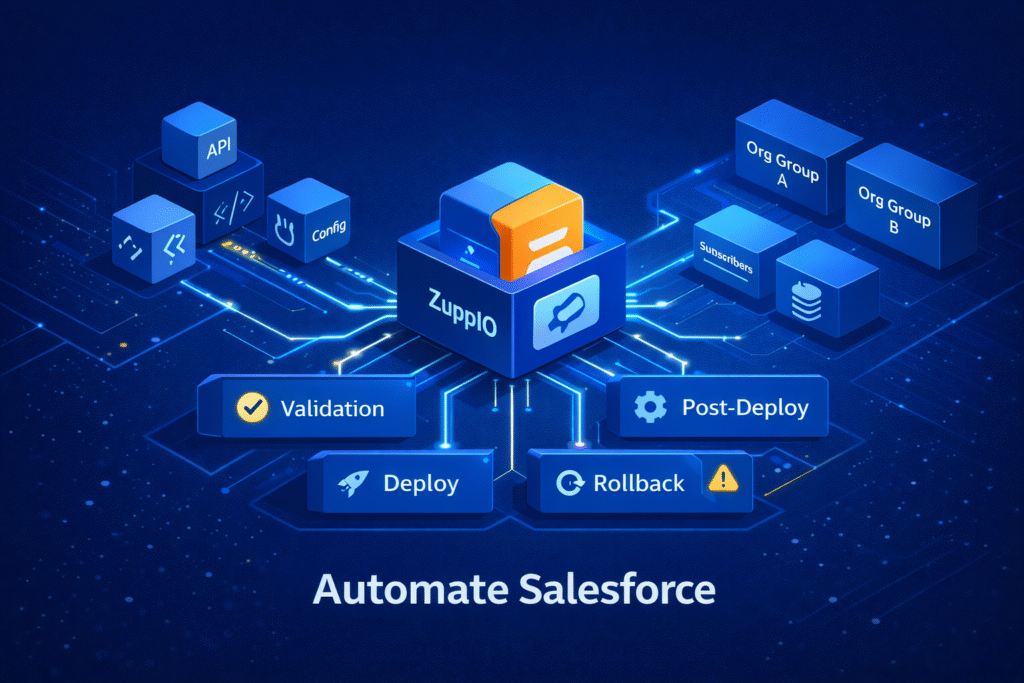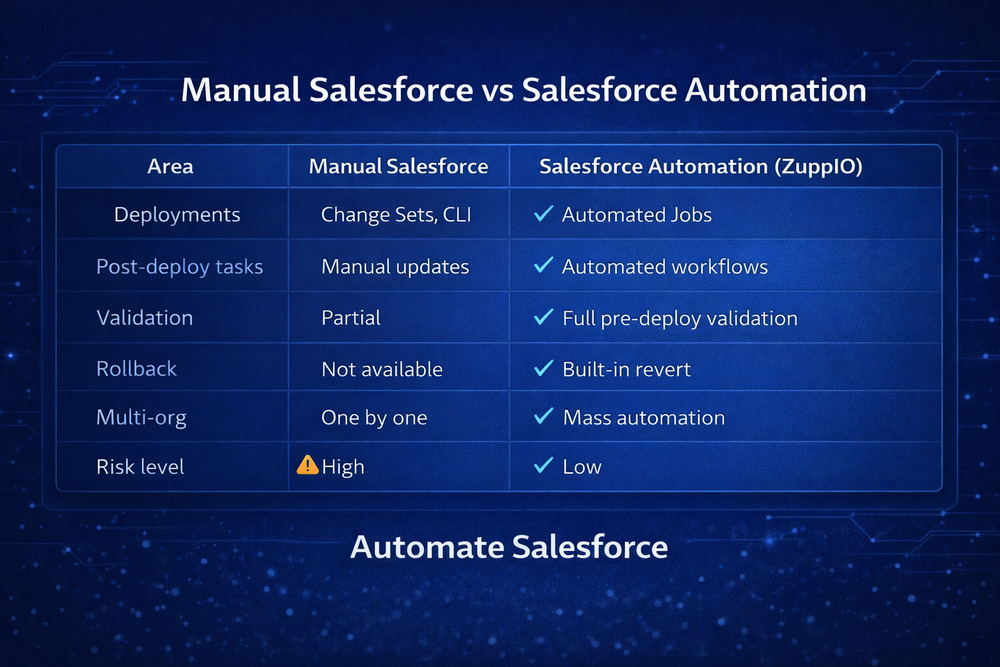Automate Salesforce: Why Manual Processes Don’t Scale Anymore
Salesforce automation has become a critical requirement for modern Salesforce teams. As organizations grow, manual processes quickly become bottlenecks that slow down releases, increase risks, and create inconsistencies across environments.
In the early stages, teams often rely on manual deployments, Change Sets, and human-driven post-deploy tasks. However, as the number of orgs, sandboxes, and subscribers increases, manual work no longer scales.
This article explains why automation is essential today, which processes must be automated, and how platforms like ZuppIO help teams move from manual operations to scalable, automated workflows.

Why Manual Salesforce Processes Stop Scaling
Manual Salesforce processes may work in small teams or early-stage projects, but they inevitably break down as systems grow. As soon as an organization manages multiple sandboxes, release cycles become more frequent, or several teams work in parallel, manual deployments start introducing delays and inconsistencies. Tasks such as validating metadata, aligning layouts, updating permissions, or running post-deploy scripts require repetitive effort and deep attention to detail. Over time, this leads to human error, configuration drift between environments, and unpredictable release outcomes. Salesforce automation becomes not a productivity upgrade, but a necessity to maintain stability, speed, and quality at scale.

What Salesforce Automation Really Means
Salesforce automation is often misunderstood as simply automating deployments. In reality, it is about automating the entire lifecycle of change delivery. This includes validating metadata before deployment, executing deployments consistently across environments, automating post-deploy tasks, and ensuring visibility and traceability for every change. True Salesforce automation removes manual decision-making from repetitive processes and replaces it with predictable, repeatable workflows. Tools like ZuppIO focus on orchestrating these workflows across multiple orgs, allowing teams to standardize how changes are delivered without relying on custom scripts or fragile pipelines.
Validation-First Automation in Salesforce
Validation-first automation is a critical principle in modern Salesforce delivery. Instead of deploying changes directly and reacting to failures afterward, teams validate changes in advance to detect issues early. Validation checks metadata dependencies, Apex tests, permission alignment, and org readiness before any real changes are applied. This approach is especially important in multi-org environments, where a deployment may succeed in one org and fail in another. By validating first, teams gain clarity on which orgs are safe to deploy to and which require fixes, significantly reducing release risk and improving overall reliability.
Automating Post-Deploy Tasks in Salesforce
Post-deployment work is where manual processes cause the most damage. After metadata is deployed, teams still need to manually adjust configurations.
Common post-deploy tasks include:
- Updating page layouts
- Synchronizing picklists
- Aligning profiles and permissions
- Running Apex initialization scripts
Without automation, these tasks are repeated manually for every org. With ZuppIO, automation extends to post-deploy actions, ensuring consistent configuration across all environments.
Salesforce Automation for Multi-Org Environments
Managing multiple orgs manually is one of the biggest challenges in Salesforce delivery. ISVs, consulting partners, and enterprise teams often maintain dozens or hundreds of orgs.
Salesforce automation allows teams to:
- Deploy changes to many orgs simultaneously
- Apply the same post-deploy configuration everywhere
- Detect failures early through validation
- Maintain consistency across environments
ZuppIO was designed specifically for multi-org automation, enabling teams to scale without increasing operational effort.
Rollback as a Core Salesforce Automation Capability
Salesforce does not provide a native rollback mechanism. When something goes wrong, teams often scramble to fix issues manually.
A mature automation strategy always includes rollback:
- Restoring previous metadata versions
- Undoing failed deployments
- Minimizing downtime
ZuppIO includes built-in revert workflows that make rollback a standard part of automation, not an emergency procedure.
Governance and Visibility Through Salesforce Automation
Automation is not only about speed. Salesforce automation also improves governance and transparency.
With automated workflows, teams gain:
- Full deployment history
- Audit logs for validation and deploy steps
- Visibility into changes across orgs
ZuppIO centralizes this information, making automation auditable and compliant with enterprise standards.
When Salesforce Automation Becomes Mandatory
Salesforce automation is no longer optional when:
- You manage more than one org
- You release frequently
- You support managed packages
- You need predictable, low-risk deployments
In these scenarios, automation is the foundation of reliable delivery.
Conclusion
Manual Salesforce processes cannot support modern delivery requirements. As environments grow, only Salesforce automation can provide the speed, safety, and scalability teams need.
By combining validation-first workflows, automated deployment, post-deploy configuration, and rollback, ZuppIO enables full automation across single and multi-org environments.
For teams ready to move beyond manual work, automation with ZuppIO is the next logical step.
What is Salesforce automation?
Salesforce automation is the process of replacing manual Salesforce operations with automated workflows for deployments, configuration, validation, and post-deploy tasks.
Why don’t manual Salesforce processes scale?
Manual processes do not scale because they require repetitive actions, increase human error, and become unmanageable across multiple Salesforce orgs.
Which Salesforce tasks should be automated first?
The most critical tasks to automate are deployments, post-deploy updates, layout synchronization, permissions, and validation workflows.
How does Salesforce automation improve CI/CD pipelines?
Salesforce automation enables consistent, repeatable deployments with validation and rollback, reducing release risk and deployment failures.
Can Salesforce automation work across multiple orgs?
Yes. Salesforce automation platforms like ZuppIO are designed specifically for multi-org automation at scale.
How does ZuppIO support Salesforce automation?
ZuppIO provides centralized Salesforce automation for validation, deployment, post-deploy tasks, CI/CD workflows, and rollback across many orgs.